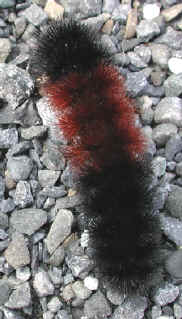 On a cold winter day, we may choose to stay inside hunkered down by the fire under a warm blanket while wearing a cozy sweater. Alternatively, we may brave the elements and enjoy the snow and crisp air all the while bundled up to help conserve heat and maintain our typical mammalian body temperature.
On a cold winter day, we may choose to stay inside hunkered down by the fire under a warm blanket while wearing a cozy sweater. Alternatively, we may brave the elements and enjoy the snow and crisp air all the while bundled up to help conserve heat and maintain our typical mammalian body temperature.
But what about the insects that during the summer and fall months frequent our gardens and move about the forest? How do they cope with the cold, snowy, often frozen landscape during the winter months? For these insects and other ectothermic animals (i.e., those whose body temperature is determined by the temperature of the surrounding environment rather than metabolically produced heat), winter may pose considerable challenges for survival. These challenges include the low, and in many cases sub-freezing, temperatures, lack of water, dramatic changes in the light-dark cycle, and limited food availability.
So what strategies do insects rely on to survive winter? A few species, for example the monarch butterfly (Danaus plexippus), have evolved to use a migratory strategy and escape to more hospitable environments well in advance of the adverse conditions. Around Erie, monarchs typically begin an approximately 2500 mile migration in mid- to late-August ultimately arriving several months later to the over-wintering grounds of spruce-fir forests in the mountains near Mexico City, Mexico.
Most insects, however, do not have the luxury of heading south and must instead tolerate the harsh conditions of the typical Erie winter. The insects that remain will characteristically over-winter in one particularly stage of their life cycle, most commonly as eggs, larvae, or pupae, and commonly enter a state of dormancy known as diapause (i.e., insect hibernation). The vast majority of these insects are freeze intolerant; that is to say, freezing of the bodily fluids is lethal and, therefore, they must adopt strategies to ensure freezing does not occur. Some will seek out protected or buffered sites to over-winter to shield them from the low temperature, for example by burrowing below the frost zone or entering our homes (e.g., lady beetles and stink bugs). Many other species will be directly exposed to winter’s low temperatures, and survive using a strategy known as supercooling or maintaining the bodily fluids in a liquid-state while at subfreezing temperatures. Supercooling is often promoted in insects through the production of antifreeze compounds (i.e., cryoprotectants) and proteins that prevent/suppress freezing and ice formation.
A few species of insects that remain and over-winter locally are freeze tolerant and can actually survive the freezing of the bodily fluids; examples include the woolly bear caterpillar (Pyrrharctia isabella) and the larva of the goldenrod gall fly (Eurosta solidaginis) commonly found within ball galls on the stem of goldenrod plants. These freeze-tolerant species can survive for days, weeks, and even months in a frozen state when exposed to subfreezing temperatures. This uniquely evolved strategy is supported by a variety of adaptations, including the production of ice nucleating agents (INAs) to seed ice formation in the body and the accumulation of chemical compounds to help stabilize cellular structures during freezing and thawing.
As we all know, Erie winters can be harsh. However, our local insects have evolved fascinating and unique strategies to enhance their cold tolerance, persist, and deal with whatever Mother Nature dishes out. Some of you might even say these insects are super-cool.

